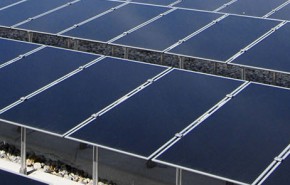While political currents are seen as shifting away from actively promoting renewable energy development, the long-term promise of sustainable, affordable energy and the momentum of major renewables projects continue to make widespread adoption of renewables a desirable and attainable goal.
Shifting Political Priorities
![]() As discussed in my last article titled “Virginia’s Renewable Energy Outlook: Funding and Progress,” the commitment to combat climate change has been key among the federal government’s motivations to fund renewable energy research, development, and adoption. Since the presidential election of November 2016, the United States has submitted formal notice of withdrawal from the Paris Climate Agreement, and the Clean Power Plan put forth by the Obama administration is in the process of being repealed. The president has openly voiced his support for the expansion of domestic industrial operations, and he has questioned the impact that these industries have on climate change.
As discussed in my last article titled “Virginia’s Renewable Energy Outlook: Funding and Progress,” the commitment to combat climate change has been key among the federal government’s motivations to fund renewable energy research, development, and adoption. Since the presidential election of November 2016, the United States has submitted formal notice of withdrawal from the Paris Climate Agreement, and the Clean Power Plan put forth by the Obama administration is in the process of being repealed. The president has openly voiced his support for the expansion of domestic industrial operations, and he has questioned the impact that these industries have on climate change.
Cuts to Government Funding
Historically, funding from federal initiatives has been key in developing renewable energy technology that is economically viable and ready for adoption in the domestic large-scale power-generation industry. President Trump has proposed to cut 31% of the Environmental Protection Agency (EPA)’s federal funding, and 6% of the Department of Energy (DoE) federal funding.
Cuts to the EPA would discontinue funding for international climate-change programs, reduce funding for the Office of Research and Development by 50%, and eliminate funding for the Office of Enforcement and Compliance. Cuts to the DoE budget would eliminate Energy Star, the Weatherization Assistance Program, the Advanced Research Projects Agency–Energy (ARPA-E), the Advanced Technology Vehicle Manufacturing Program, and Title 17 loan guarantees for Innovative Energy Technologies. The proposed DoE cuts would also reduce by 70% funding to the Energy Efficiency and Renewable Energy Office (EERE), which manages renewable energy initiative funding distribution and management. [1]
Renewables May Become Less Competitive
The president’s proposed budget as detailed above removes most federal funding for innovations in renewable energy research and development, eliminates incentives for installing energy-efficiency measures to reduce residential energy consumption, and slows the commercial vehicle industry’s progress towards higher fuel economy.
Since most of the cost of a renewable energy installation is based on initial project expenditures, it is very important to perform the research and development needed to optimize renewable technologies to make them more affordable and become more cost-competitive with fossil-fueled energy generation. Another factor is that new environmental regulations imposing limits on air emissions and water chemistry result in expenditures made by power-generation companies toward complying with those regulations. These required expenditures can also help make renewable energy affordable when compared to conventional power-generation technologies.
This works in the following way: fossil-fueled energy generation sites must spend significant money on permitting and regular environmental evaluations and treatment of any air or water outfalls from their sites, where wind and solar installations have none of these outputs or costs. Under the current administration, these new environmental regulations may be reduced or eliminated, further hindering the economic viability of renewable energy as compared to fossil-fueled energy generation developments.
To see how this plays out in the market, on October 27, 2017, Florida Power & Light[2] proposed constructing a new natural gas fired unit in an existing facility, using a cost comparison to show that the unit would be “almost $1.3 billion cheaper than developing the same amount of solar energy.” This example serves to illustrate that power utilities recognize that their customers want to see increased renewable developments, but must balance this with a desire to maintain low electricity prices.
Solar Energy’s Environmental Impact
There is one substantial cost for solar energy that is often overlooked: since about 95% of solar photovoltaic panels sold in the United States in 2016 were made abroad[3], the perception of the environmental footprint associated with solar energy is skewed.
![]()
Nearly half of the world’s solar equipment is made in China—in addition to Malaysia, the Philippines, and Taiwan—where quartz is harvested and processed to produce the polysilicon wafers integral to solar panel technology. For every ton of polysilicon manufactured, approximately 3-4 tons of compound silicon tetrachloride is produced, which, when exposed to water, releases hydrochloric acid that is particularly harmful to the environment due to the impacts to water, soil, and air if not recycled or disposed of properly[4]. As small- and large-scale solar developments expand across the United States and abroad, the resulting solar manufacturing waste needs to be considered.
Solar’s Scalability, Safety, & Tax Incentives Are Major Advantages
Despite solar energy’s manufacturing waste challenges, the technology remains extremely appealing as it presents unique benefits that no other power generation option can match, namely, scalability and safety.
Solar panel technology is sold in a small unit size, which is easy to group and scale as desired, and poses very little safety threat as situated proximal to surrounding buildings and populations. Additionally, suggested cuts to the DoE budget leave its federal solar energy tax credit (ITC) intact, which is currently the most powerful incentive for large- and small-scale solar projects.
In addition to federal financial incentives, the appealing characteristics of solar technology have played a big part in facilitating large data center developments in Virginia. These data centers are capitalizing on solar state resources and incentive funding, and they are cooperating with local utilities to develop additional solar farms dedicated to meeting the data centers’ power needs.
Private Off-Shore Wind Projects Move Forward
While wind energy generation technology is not as easily incorporated into populous environments as is solar, and financial incentive programs supporting wind energy developments have been defunded, there is still hope for the continued success and adoption of this renewable energy technology.
The United States’ first large- and pilot-scale off-shore wind projects are still moving forward without federal funding. The completion of these projects is motivated by the desire to meet state power plan renewable energy goals and to generate profits for both power utilities and wind developers.
 Dominion Energy’s[5] Coastal Virginia Offshore Wind project is a pilot-scale development of two 6-megawatt wind turbines 27 miles off the coast of Virginia Beach, undertaken in partnership with Danish company DONG Energy. These turbines, owned by Dominion Energy, will sit adjacent to an 112,800-acre site leased by Dominion Energy and the Bureau of Ocean Energy Management (BOEM).
Dominion Energy’s[5] Coastal Virginia Offshore Wind project is a pilot-scale development of two 6-megawatt wind turbines 27 miles off the coast of Virginia Beach, undertaken in partnership with Danish company DONG Energy. These turbines, owned by Dominion Energy, will sit adjacent to an 112,800-acre site leased by Dominion Energy and the Bureau of Ocean Energy Management (BOEM).
The future success of this pilot-scale installation presents a potential for expansion into a larger wind farm as well as economic growth in the Virginia Beach area to support the completion and ongoing operation of such a project.- The 90-megawatt South Fork Wind Farm off the coast of Long Island, New York will be the United States’ largest offshore windfarm and could be operational as soon as 2022. This project work will be paid for and completed by a U.S. company called Deepwater Wind, which has set up an agreement with the local power utility to purchase all power produced from this installation[6].
Renewable Energy Forecast: Short-Term Challenges, Long-Term Promise
Short-term legislation is shifting away from environmental protections and enforcement, as well as cutting funding formerly devoted to the research and development that makes renewable energy installations cost competitive with conventional fossil fuels. However, the solar power generation industry is still supported by some federal funding until 2020, and both the solar and wind power generation industries have gained enough momentum in the last decade to carry on into continued viability and technology adoption.
As long as we can continue to advance the material makeup of these technologies to increase their affordability and reduce their environmental impact and resource consumption—particularly for solar photovoltaic technology—an energy mix with an increasing percentage of sustainable, renewable energy will continue to lead to reduced dependence on finite fossil fuel resources and the reduction of greenhouse gas emissions.
Sources:
[2] https://www.utilitydive.com/news/florida-power-light-proposes-new-888m-gas-unit/507858/
[4] https://spectrum.ieee.org/green-tech/solar/solar-energy-isnt-always-as-green-as-you-think
https://www.energysage.com/solar-rebates-incentives/va/


